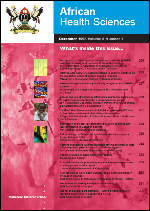
|
African Health Sciences
Makerere University Medical School
ISSN: 1680-6905
EISSN: 1680-6905
Vol. 16, No. 3, 2016, pp. 698-703
|
 Bioline Code: hs16089
Bioline Code: hs16089
Full paper language: English
Document type: Study
Document available free of charge
|
|
|
African Health Sciences, Vol. 16, No. 3, 2016, pp. 698-703
| en |
Comparing concentration Methods: parasitrap® versus Kato-Katz for studying the prevalence of Helminths in Bengo province, Angola.
Mirante,Clara; Clemente,Isabel; Zambu,Graciette; Alexandre,Catarina; Ganga,Teresa; Mayer,Carlos & Brito,Miguel
Abstract
Background: Helminth intestinal parasitoses are responsible for high levels of child mortality and morbidity. Hence, the capacity
to diagnose these parasitoses and consequently ensure due treatment represents a factor of great importance.
Objectives: The main objective of this study involves comparing two methods of concentration, parasitrap and Kato-Katz, for
the diagnosis of intestinal parasitoses in faecal samples.
Methods: Sample processing made recourse to two different concentration Methods: the commercial parasitrap® method and
the Kato-Katz method.
Results: We correspondingly collected a total of 610 stool samples from pre-school and school age children. The results demonstrate
the incidence of helminth parasites in 32.8% or 32.3% of the sample collected depending on whether the concentration
method applied was either the parasitrap method or the Kato-Katz method. We detected a relatively high percentage of samples
testing positive for two or more species of helminth parasites. We would highlight that in searching for larvae the Kato-Katz
method does not prove as appropriate as the parasitrap method.
Conclusion: Both techniques prove easily applicable even in field working conditions and returning mutually agreeing results.
This study concludes in favour of the need for deworming programs and greater public awareness among the rural populations
of Angola.
Keywords
Concentration methods; parasitrap® versus Kato-Katz; helminths; Bengo province; Angola
|
| |
© Copyright 2016 - African Health Sciences
|
|
